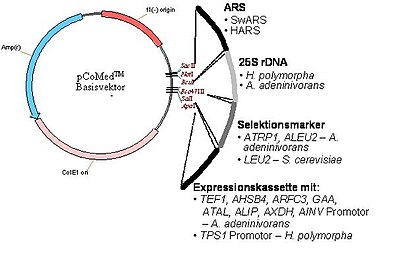Blastobotrys adeninivorans
| Blastobotrys adeninivorans | ||||||||||||
|---|---|---|---|---|---|---|---|---|---|---|---|---|

Microscopic representation of B. adeninivorans cells cultured at 30 ° C (a), 37 ° C (b), 42 ° C (c) and 45 ° C (d). You can see the transition from normal yeast cells to filamentous cells from 42 ° C |
||||||||||||
| Systematics | ||||||||||||
|
||||||||||||
| Scientific name | ||||||||||||
| Blastobotrys adeninivorans | ||||||||||||
| ( Middelhoven , Hoogk.-Niet & Kreger ) Kurtzman & Robnett |
Blastobotrys adeninivorans , also Arxula adeninivorans , is a dimorphic yeast species with unusual properties. It was first described in the mid-1980s and initially called Trichosporon adeninivorans .
Basics
After their discovery in the Netherlands, strains of this type were found in Siberia and South Africa. They were isolated from soil samples and wood hydrolysates . After detailed phylogenetic comparisons with related yeast species, Arxula adeninivorans was renamed Blastobotrys adeninivorans in 2007 . However, the previous scientific name is still widely used. All B. adeninivorans strains exhibit unusual biochemical activities. In addition to various sugars , they are able to use amines , adenine (hence the name adeninivorans ) and other purines as the only carbon source. They can also assimilate nitrate and are thermotolerant , meaning that they can grow at temperatures up to 48 ° C. A special characteristic of biotechnological importance is a temperature-dependent dimorphism . At temperatures above 42 ° C, a reversible conversion of normal yeast cells into filamentous forms (similar to that of mold ) is induced. Yeast forms return when the cultivation temperature drops below 42 ° C. The change in morphology is associated with differences in the secretion of proteins and in the modification (attachment of sugar chains) (see figure in Taxobox).
Biotechnological potential

The unusual properties described above make B. adeninivorans an attractive organism for biotechnological applications. On the one hand, yeast is a source of many enzymes with interesting properties for industrial applications and the corresponding genes, including glucoamylases, tannase, lipases, phosphatases and many others. On the other hand, B. adeninivorans is a very robust and safe organism that, after genetic modification, can be used to produce proteins on an industrial scale. For this purpose, suitable host strains are transformed with plasmids , which contain, among other things, the genetic instructions for producing such proteins (see Figure 2). The basic structure of such plasmids is similar to that described under the Wikipedia keyword Hansenula polymorpha .
Applications in biotechnology
A company and an academic institute use this yeast for such applications. Here are two examples of genetically modified strains and their application: In both cases, several plasmids with different protein genes were transferred to the yeast at the same time. In the first example, a strain was genetically modified to produce a biodegradable plastic material, namely PHA ( polyhydroxyalkanoate ). To do this, a new synthetic route consisting of three enzymatic steps had to be transferred to the yeast. The corresponding genes phbA , phbB and phbC were isolated from the bacterium Ralstonia eutropha and integrated into plasmids in a suitable form that can be used by the yeast. These plasmids were introduced into the yeast and the genetically modified organism created in this way was able to produce the plastic material efficiently. In the second example, a biosensor was developed for the detection of estrogens in environmental samples. For this, the chain of effects of estrogen in yeast was imitated. First, a gene for the human estrogen receptor alpha ( hERalpha ) was transferred to the yeast on a first plasmid . Such a receptor recognizes and binds the hormone. After the estrogen has bound, the receptor interacts with a second gene that is activated by this interaction. Such a “reporter gene” was transferred to the yeast on a second plasmid. The “reporter gene” contains the production instructions for the production of a protein that can be easily detected with simple tests, such as an enzyme or a dye - in this case this gene was present as a fusion to a control element, a promoter, which was modified to the receptor / Hormone Complex. Such a modified strain can be cultivated in the presence of waste water samples. The concentration can then be precisely determined in relation to the amount of the reporter gene product (such as color intensity or enzyme activity).
swell
- ↑ Gerhard Steinborn, Erik Böer, Anja Scholz, Kristina Tag, Gotthard Kunze, Gerd Gellissen: Application of a wide-range yeast vector (CoMed ™) system to recombinant protein production in dimorphic Arxula adeninivorans, methylotrophic Hansenula polymorpha and other yeasts . In: Microbial Cell Factories . tape 5 , 2006, ISSN 1475-2859 , pp. 33 , doi : 10.1186 / 1475-2859-5-33 .
- ↑ Yeast Genetics Working Group - Research Areas. IPK-Gatersleben, archived from the original on February 24, 2015 ; Retrieved August 18, 2012 .
literature
- G. Gellissen (Ed.): Production of recombinant proteins - novel microbial and eukaryotic expression systems. Wiley-VCH, Weinheim 2005, ISBN 978-3-527-31036-4 .